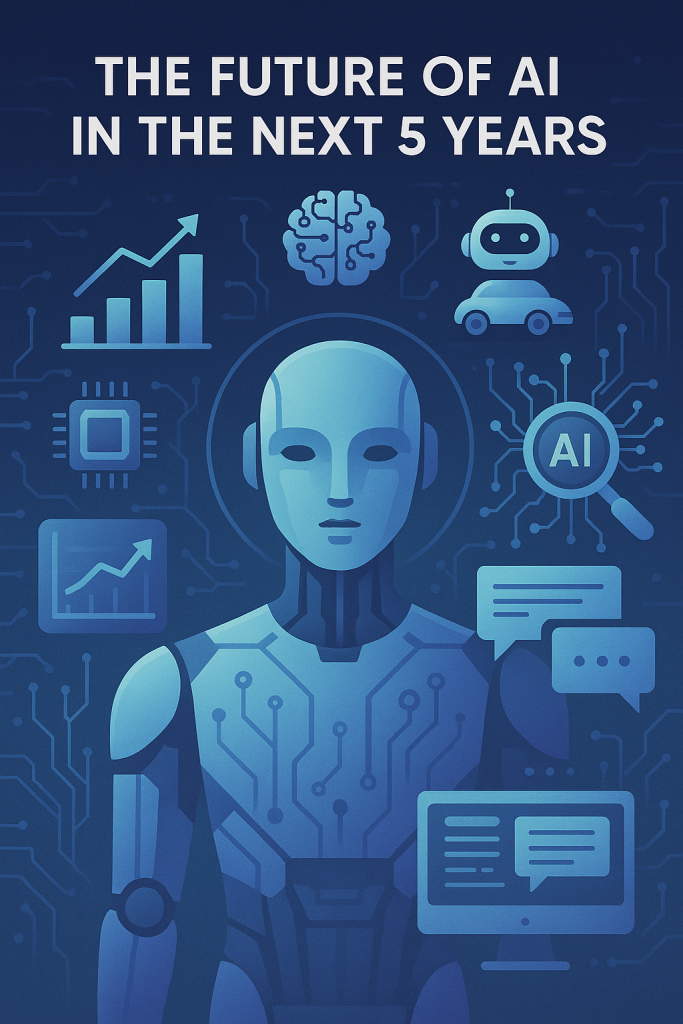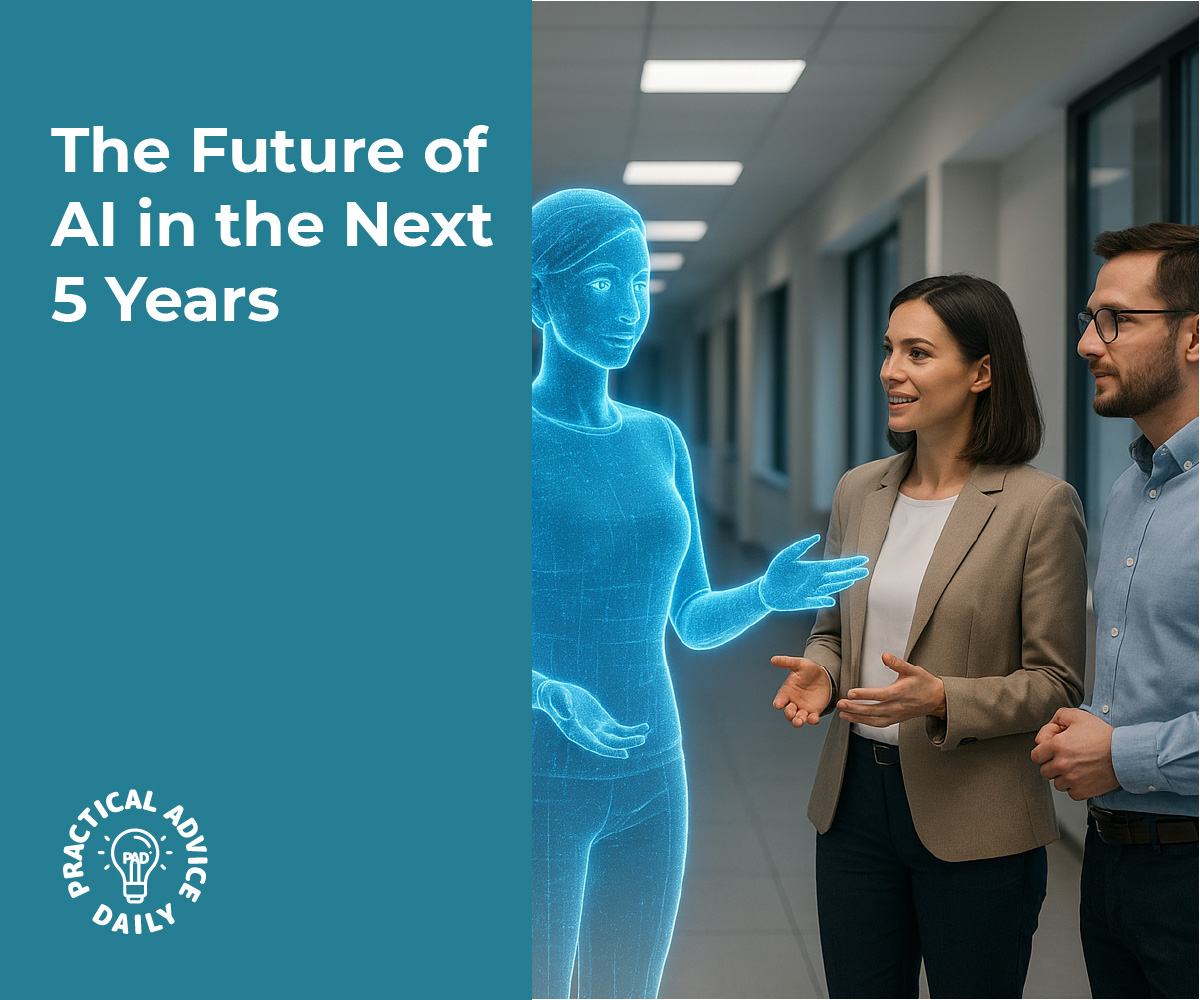Artificial intelligence, or AI, is no longer just a science fiction idea. Many of us already use it without thinking: when Netflix suggests a show, when a smartphone helps type faster, or when a voice assistant gives directions.
But what about the near future? In the next five years, experts predict AI will expand in ways that touch nearly every part of life—our jobs, our hobbies, and even how we shop or stay healthy.
This article breaks it down in simple terms, with everyday examples and easy steps to help you try AI for yourself. No technical background required.
Table of Contents
Key Takeaways
- AI is becoming more of a “co-worker” than a job replacement.
- Creative tools powered by AI will help anyone make art, music, or stories.
- Everyday routines—from health to shopping—will be smoother with AI in the background.
- Privacy, fairness, and trust will remain important challenges.
- You can already try small, safe AI tools at home to get comfortable.
AI in the Workplace
In five years, AI will likely be a bigger part of office jobs, healthcare, and customer service. But instead of replacing people, it will often act like a smart assistant.
Real-life examples
- Office tasks: Imagine writing a long report. AI could summarize it into a one-page brief for your boss in seconds. Tools like Microsoft Copilot and Google’s AI assistants are already moving in this direction.
- Healthcare: Doctors may use AI to review X-rays or blood tests more quickly, helping them catch problems earlier. For patients, this means faster answers and fewer delays.
- Customer service: Chatbots will get better at handling common questions. If you forgot your online password or need to track an order, AI could solve it without waiting on hold.
Try it yourself
- Use Grammarly or Wordtune to polish your emails and documents.
- Try ChatGPT or Google’s Gemini to draft letters, summaries, or meeting notes.
- If you’re in healthcare, apps like Ada Health or Mayo Clinic’s symptom checker use AI to give possible explanations before you visit a doctor.
AI in Creativity
The next few years may feel like a creative boom. AI tools will make it easier for anyone—no matter their background—to bring ideas to life.
Real-life examples
- Writing and storytelling: AI can already help draft stories or articles. In five years, you might tell an AI, “Write me a short story about my grandchildren at the beach,” and get a warm, illustrated tale in minutes.
- Art and music: Someone with no painting skills could create a digital picture for a birthday card by describing it in words. Musicians may hum a tune and have AI build it into a full song.
- Collaboration: Professional artists may use AI as a brainstorming partner. For example, an author might use AI to generate ten possible titles for a new book.

Try it yourself
- Create artwork with free tools like Canva (now offering AI design help) or Bing Image Creator.
- Use Suno AI or Boomy to make a simple song from scratch—even if you’ve never played an instrument.
- Ask ChatGPT to help brainstorm ideas for a family history, a poem, or a recipe collection.
AI in Everyday Life
AI won’t just stay in offices and studios. It’s set to quietly make daily routines smoother and more personal.
Real-life examples
- Health and wellness: Smart watches are already tracking steps and heart rates. Soon, they could alert you if your sleep patterns suggest early health issues.
- Shopping: Online stores may become smarter. Instead of random suggestions, you might see clothes in your size, in colors you like, and matched with items you already own.
- Home technology: Smart homes may get better at predicting your habits. Imagine your house turning on the kettle when your morning alarm rings, or adjusting the lights when you sit down to read.
Try it yourself
- Use MyFitnessPal or Fitbit apps to track nutrition and activity.
- Try a smart speaker like Amazon Echo or Google Nest to control lights, music, or reminders.
- Explore personalized shopping with Stitch Fix (AI-powered clothing suggestions) or even Amazon’s recommendations.
Challenges and Questions
Of course, not all changes are simple. As AI becomes more powerful, three challenges will stay in the spotlight:
- Privacy: AI often needs personal data to work well. How much are you comfortable sharing?
- Fairness: If AI helps decide who gets a loan or a job interview, we need to be sure it doesn’t favor some people unfairly.
- Trust: AI is not perfect. It can make mistakes, and people may struggle to know when to trust its advice.
Try it yourself
- Review the privacy settings on your apps and devices. Most have an option to limit data sharing.
- Ask questions: if a company uses AI, see if they explain how it works and what data it collects.
- Stay updated with trusted news sources about new AI policies and protections
What the Next 5 Years May Feel Like
Instead of giant, shocking changes, the next five years of AI will probably feel like many small improvements adding up.
- At work, AI will help you move through tasks faster.
- At home, AI will quietly personalize your environment.
- In creativity, AI will act like a fun partner, helping turn ideas into reality.
Think of it less like a robot takeover and more like getting new “power tools” for everyday life.
Final Thoughts
The future of AI in the next five years looks practical, supportive, and sometimes even fun. It won’t solve everything, but it will likely make life easier in small, steady ways.
For most people, the key is not to fear AI, but to try it little by little. Write a draft with AI, create a song for fun, or let your smart speaker set reminders. The more you explore, the more confident you’ll feel when bigger changes arrive.
If you stay curious and open to experimenting, AI may surprise you with how much it can simplify your work, inspire your creativity, and brighten your daily routines.
